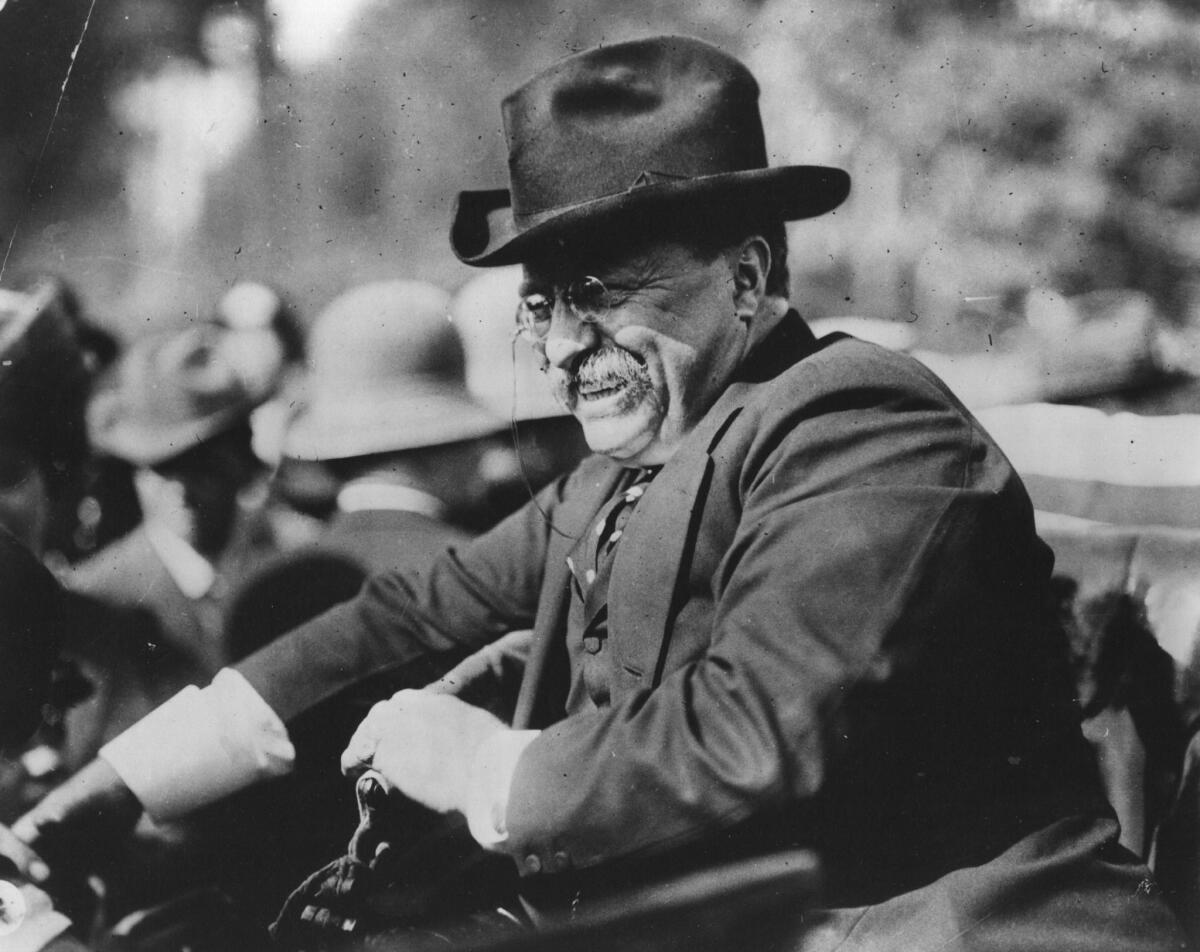Louis Bayard’s ‘Roosevelt’s Beast’ is a diverting expedition

- Share via
As even the most casual student of American history knows, Theodore Roosevelt was a larger-than-life figure. Besides being our 26th president, he was an outdoorsman, an explorer, a historian and a war hero.
T.R.’s adventures on the campaign trail, the battlefield and on African safaris have served as material for many works of fiction and nonfiction. In “Roosevelt’s Beast,” the novelist Louis Bayard takes on one of his lesser-known exploits — his 1914 expedition to map a Brazilian rain forest waterway with an appropriately harrowing and mythical name, “the River of Doubt.”
Roosevelt had recently lost, badly, in his final political campaign, running as the Progressive Party presidential nominee and finishing a distant second to Woodrow Wilson. Never one to stay inactive, Roosevelt departed for South America on a speaking tour and found himself accepting an invitation from the legendary Brazilian explorer Cândido Rondon.
“Roosevelt’s Beast” tells this story from the point of view of the former president’s son, Kermit, an intelligent and sensitive man who can’t escape the shadow of his charismatic father.
“What a strange sight they must have been!,” Kermit thinks as the expedition proceeds along the River of Doubt. “A small band of bedraggled white men, outnumbered by both their porters and their trunks, hustling northward down a twisting ribbon of black water, with an air of deep intention. Looking for something, but what?”
The answer, Kermit knows, is that “They weren’t looking for anything and anyone in particular.” They were in fact filling in one of the final black spots on the map of the Western Hemisphere and thus “merely attempting to see where this river would take them.”
Bayard has written six previous novels, including the bestselling “The Pale Blue Eye,” a historical mystery. His description of this obscure incident of South American history is powerfully evocative in its opening chapters, as he hews close to the actual events and their real-life particulars.
There is Rondon, who had already mapped much of the western Amazon basin, with more than a few members of his previous expeditions killed by raging currents and unconquered tribesmen in the process. And there is the landscape itself, with its jaguars and unseen and uncivilized natives rustling around the wooded riverbanks. And finally, there is the incongruity of a talkative former U.S. president subjecting himself to deprivations as the expedition’s supplies start to run out.
“The Colonel,” as the former president is known to his son, is finally so beaten down by hunger and illness he stops talking. “So he sat there,” Bayard writes. “Sat for long minutes, studying the river. The river that was killing them.”
But the novel’s emotional center is Kermit. As the expedition sets off, he’s become engaged to the daughter of the U.S. ambassador to Spain. He’s haunted by various family demons, including the knowledge that he resembles (in appearance and in disposition) an uncle who was a notorious depressive and drunk.
Kermit wants nothing more than to be reunited with his love (to whom he’s proposed by mail), but his famous father’s needs stand in the way. The narcissistic former president cannot be without an audience for his exploits. And his family members must always be sitting in the front row.
“Don’t you understand how this family works by now?” Kermit’s mother tells him. “Father needs his scope. And we are the ones who give it to him.”
Bayard’s untangling of the Roosevelt family dynamics and of Kermit’s personal suffering suggest that Bayard intends to explore deep emotional waters as well as natural ones. But after just four chapters, his serious novel takes a strange, melodramatic turn.
Kermit and T.R. are captured by an Amazonian tribe, the “Cinta Larga,” or the “men of the long belts.” No such thing happened in real life, and Bayard’s decision to invent the kidnapping of a former U.S. president and somewhat implausible events that follow places “Roosevelt’s Beast” firmly in the “historical thriller” genre. As Bayard himself puts it in a note at the end, the book is “a psychological fantasy built out of historical events.”
To win his freedom, the former president, who famously hunted lots of big game in his lifetime, must now track down a mysterious “beast” that’s been haunting the Cinta Larga tribe. The tribe sees the white men in their midst as another kind of beast, Kermit realizes. The Beast, one tribal member tells him, will never harm “one of its own.”
More strange and entertaining things happen — including the appearance of a ghost and rappelling down a cliff with jungle vines — all of which seem more appropriate to an action-adventure movie.
The real story behind the Rondon-Roosevelt expedition was recounted with great skill by Candice Millard in her 2005 nonfiction “The River of Doubt: Theodore Roosevelt’s Darkest Journey,” a book Bayard cites in his acknowledgments. Many of the elements that helped make that book a bestseller (the larger-than-life Rondon, for example) are actually played down in “Roosevelt’s Beast.”
Still, Bayard’s linguistic gifts are ample and on display repeatedly in “Roosevelt’s Beast.” Those readers willing to suspend belief in the name of adventure will likely enjoy the ride on which he takes them.
Roosevelt’s Beast
A novel
Louis Bayard
Henry Holt: 320 pp., $27
More to Read
Sign up for our Book Club newsletter
Get the latest news, events and more from the Los Angeles Times Book Club, and help us get L.A. reading and talking.
You may occasionally receive promotional content from the Los Angeles Times.









